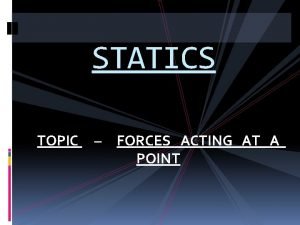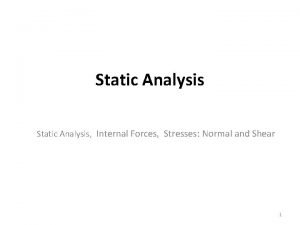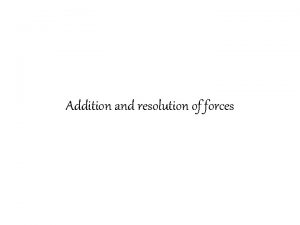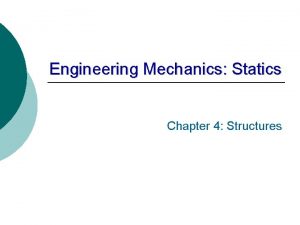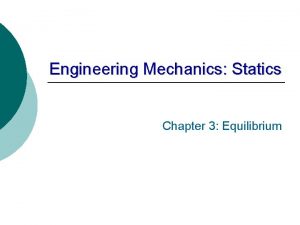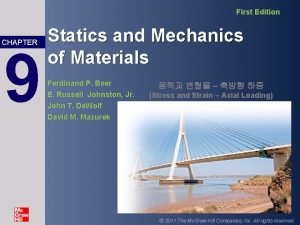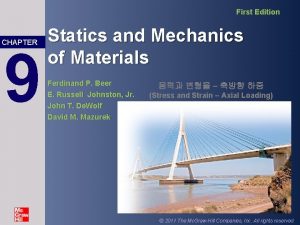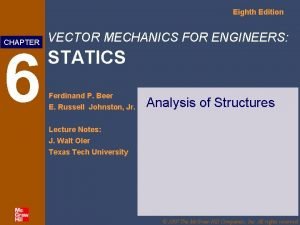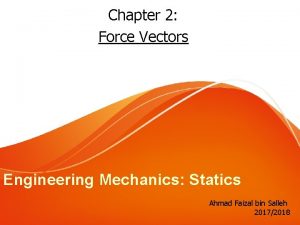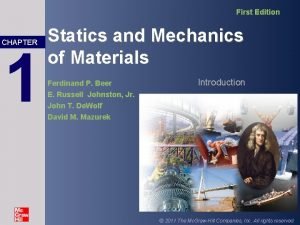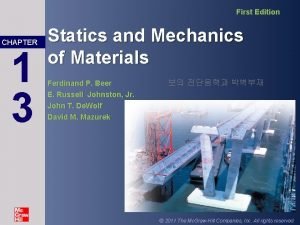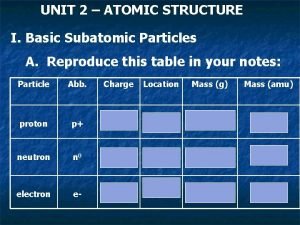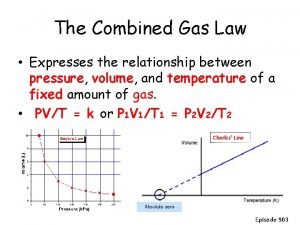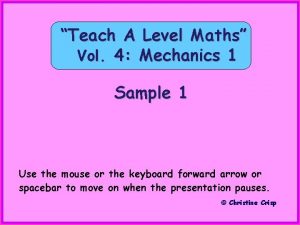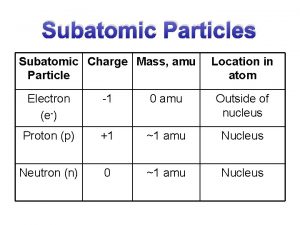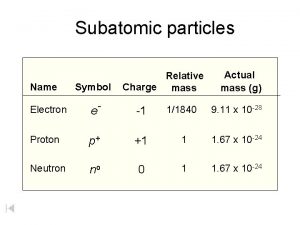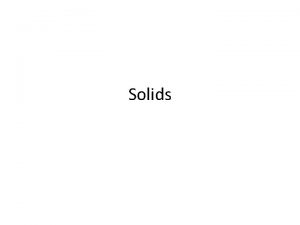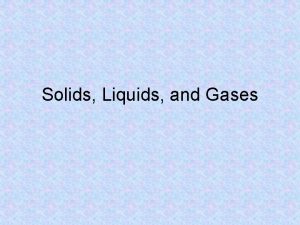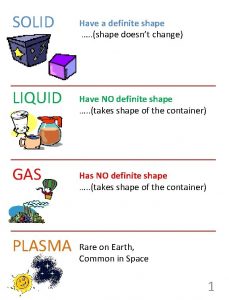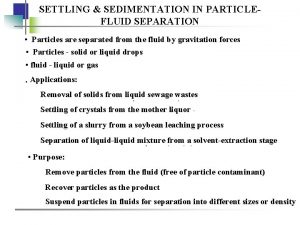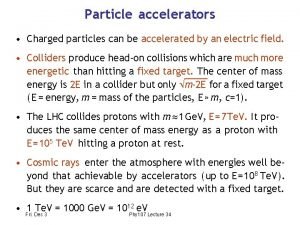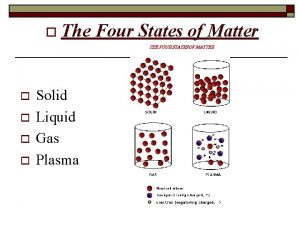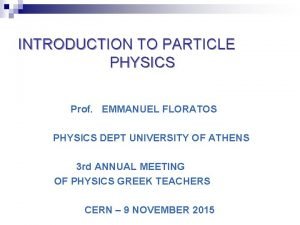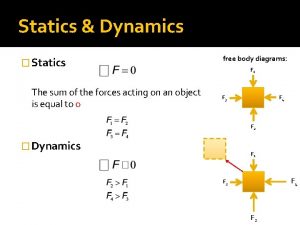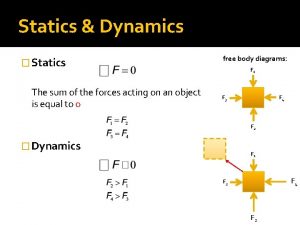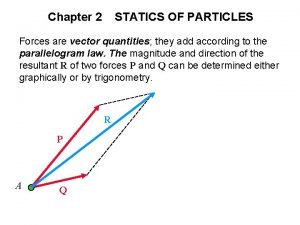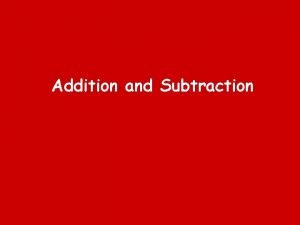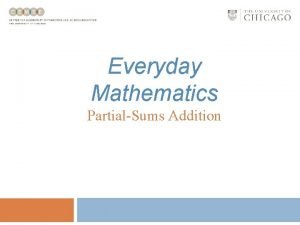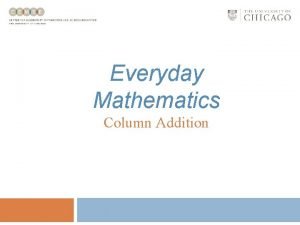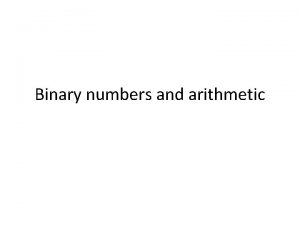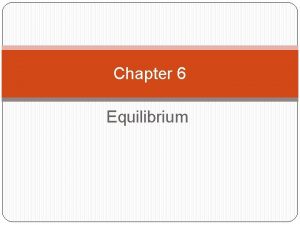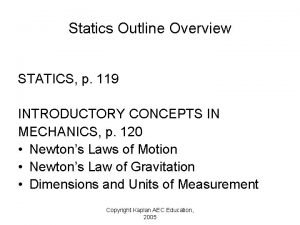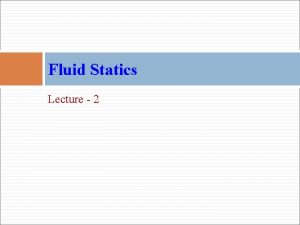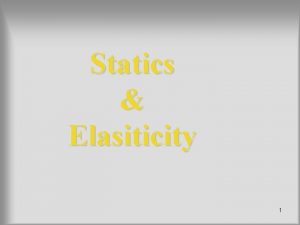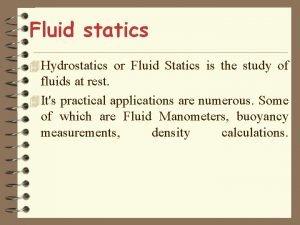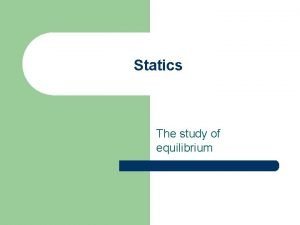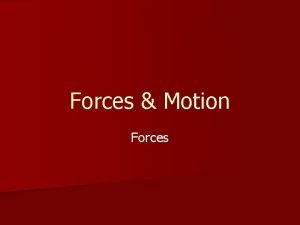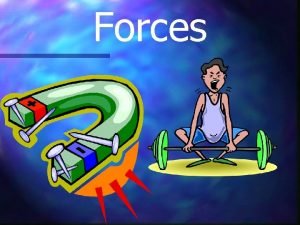Chapter 2 Statics of Particles Addition of Forces










































- Slides: 42

Chapter 2 Statics of Particles

Addition of Forces Parallelogram Rule: The addition of two forces P and Q : Draw two parallel lines of vectors to form a parallelogram Draw the diagonal vector represent the resultant force → P A → Q → → → P+ Q = R

Addition of Forces Triangle Rule: Alternative method to Parallelogram Rule Arrange two vectors in tip-to-tail fashion Draw the vector from starting point to the tip of second vector → P → → A → Q → P+ Q = R

Addition of Forces Triangle Rule: The order of the vectors does not matter → → → P+ Q = R A → Q Addition of two forces is commutative → → P + Q = Q+ P

Addition of Forces More than two forces: Arrange the given vectors in tip-to-tail fashion Connect the tail of first vector to the tip of last vector → → P+ Q + S = R → S → P A → Q

Addition of Forces More than two forces: The order of the vectors does not matter → Q → P → → → S P+ Q + S = R → S A A → Q → → → + = S+ P Q Q+ S + P → → → = P+ Q + S

Rectangular Components of a Force → → Fx , Fy + → → F = Fx → Rectangular components of F θ : Angle between x-axis and F measured from positive side of x-axis → Fy

Rectangular Components of a Force Unit Vectors → → Unit vectors i , j

Rectangular Components of a Force Unit Vectors → → Unit vectors i , j

Rectangular Components of a Force Example A Force of 800 N is applied on a bolt A. Determine the horizontal and vertical components of the force

Rectangular Components of a Force Example A man pulls with a force of 300 N on a rope attached to a building. Determine the horizontal and vertical components of the force applied by the rope at point A

Addition of Forces by Summing Their components → P → S A → Q → → P+ Q + S = R

Addition of Forces by Summing Their components - Example Problem 2. 22 on page 33 Determine the resultant force applied on the bolt Force 7 k. N 9 k. N 5 k. N Magnitude x Component F 1 5 k. N 5* cos (40) = 5* sin (40) = 3. 83 k. N 3. 21 k. N F 2 7 k. N 7*cos(110)= -2. 39 k. N 7* sin (110)= 6. 57 k. N F 3 9 k. N 9*cos(160)= -8. 46 k. N 9* sin(160)= 3. 08 k. N -7. 01 k. N 12. 86 k. N R y Component

Equilibrium of Particle When the resultant of all the forces acting on a particle is zero, the particle is in equilibrium

Equilibrium of Particle - Example Determine the resultant force applied on point A N N N Force Magnitude x Component y Component F 1 300 0 F 2 173. 2 0 -173. 2 F 3 200 -173. 2 F 4 400 -200 346. 4 0 0 N 200*cos(240) = -100 200*sin(240) = -173. 2 R

Equilibrium of Particle – Newton’s First Law If the resultant force acting on a particle is zero, • the particle remains at rest (if originally at rest) • the particle moves with a constant speed in a straight line ( if originally in motion) Equilibrium State

Equilibrium of Particle - Example Load with mass of 75 kg Determine the tensions in each ropes of AB and AC N N N 200*cos(240) = -100 200*sin(240) = -173. 2 Since the load is in equilibrium state, The resultant force at A is zero.

Equilibrium of Particle – Example (continued) (1) N (2) N N 200*cos(240) = -100 200*sin(240) = -173. 2

Equilibrium of Particle – Example-2 Two cables are tied together at C and they are loaded as shown Determine the tensions in cable AC and BC Problem 2. 44 / page 41

Equilibrium of Particle – Example-2 Draw “Free Body” Diagram C

Equilibrium of Particle – Example-2 For simplicity C

Equilibrium of Particle – Example-2 Since the system is in equilibrium The resultant force at C is zero. C

Equilibrium of Particle – Example-2 Since the system is in equilibrium The resultant force at C is zero. C

Equilibrium of Particle – Example-2 C (1) (2)

Equilibrium of Particle – Example-2 (1) C (2)

Forces in Space ( 3 D )

Forces in Space ( 3 D )

Forces in Space ( 3 D ) • The three angle define the direction of the force F • They are measured from the positive side of the axis to the force F • They are always between 0 and 180º

Forces in Space ( 3 D )

Forces in Space ( 3 D ) • The vector is the unit vector along the line of action of F

Forces in Space ( 3 D ) • The vector is the unit vector along the line of action of F

Forces in Space ( 3 D )

Forces in Space ( 3 D ) Direction of the force is defined by the location of two points,

Forces in Space ( 3 D )

Sample Problem 2. 7 The tension in the guy wire is 2500 N. Determine: a) components Fx, Fy, Fz of the force acting on the bolt at A, b) the angles qx, qy, qz defining the direction of the force

Sample Problem 2. 7 • Determine the components of the force.

Sample Problem 2. 7 • Noting that the components of the unit vector are the direction cosines for the vector, calculate the corresponding angles. or

Addition of Concurrent Forces in Space • The resultant R of two or more vectors in space

Sample Problem 2. 8 m A concrete wall is temporarily held by the cables shown. m The tension is 840 N in cable AB and 1200 N in cable AC. m m Determine the magnitude and direction of the resultant vector on stake A

Sample Problem 2. 8

Equilibrium of a Particle in Space When the resultant of all the forces acting on a particle is zero, the particle is in equilibrium

Problem 2. 103 on page 60
 Forces acting at a point in statics
Forces acting at a point in statics Internal forces in structures engineering mechanics
Internal forces in structures engineering mechanics Fbd
Fbd Addition of forces
Addition of forces What is the parallel force
What is the parallel force The forces shown above are
The forces shown above are Intermolecular vs intramolecular
Intermolecular vs intramolecular Interu
Interu Inter vs intramolecular forces
Inter vs intramolecular forces Contact and non contact forces
Contact and non contact forces Unbalanced force
Unbalanced force Constructive forces and destructive forces
Constructive forces and destructive forces Chapter 6 ions charged particles in solution
Chapter 6 ions charged particles in solution Engineering mechanics: dynamics chapter 4
Engineering mechanics: dynamics chapter 4 Statics chapter 3
Statics chapter 3 Engineering mechanics statics chapter 2 solutions
Engineering mechanics statics chapter 2 solutions Hooke의 법칙
Hooke의 법칙 Statics chapter 9
Statics chapter 9 Statics chapter 6
Statics chapter 6 Chapter 2 force vectors solutions
Chapter 2 force vectors solutions Statics chapter 1
Statics chapter 1 Statics
Statics On heating solids
On heating solids Subatomic particles table
Subatomic particles table Christian schill
Christian schill Calcium subatomic particles
Calcium subatomic particles Combined gas laws
Combined gas laws Connected particles a level maths
Connected particles a level maths Mass of subatomic particles in amu
Mass of subatomic particles in amu Mass number
Mass number Definite arrangement
Definite arrangement Kinetic theory of solids
Kinetic theory of solids Solid
Solid Solid to gas
Solid to gas Is terminal velocity constant
Is terminal velocity constant The search for fractionally charged particles has–
The search for fractionally charged particles has– Conduction convection and radiation venn diagram
Conduction convection and radiation venn diagram Photochromic particles
Photochromic particles Charged particles can be accelerated by
Charged particles can be accelerated by Plasma particle arrangement
Plasma particle arrangement Solid liquid and gas particles
Solid liquid and gas particles Buoyancyability
Buoyancyability Point like particles
Point like particles
